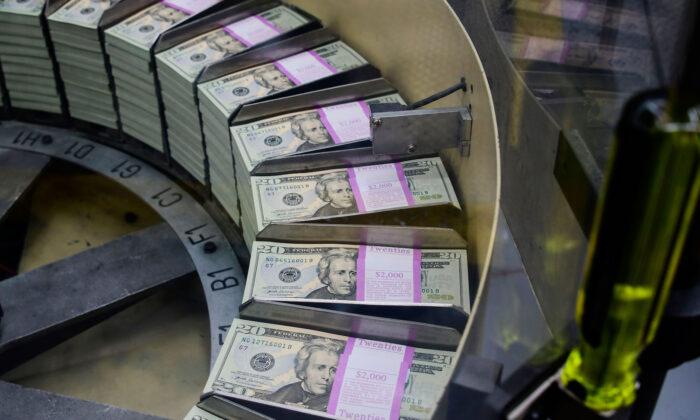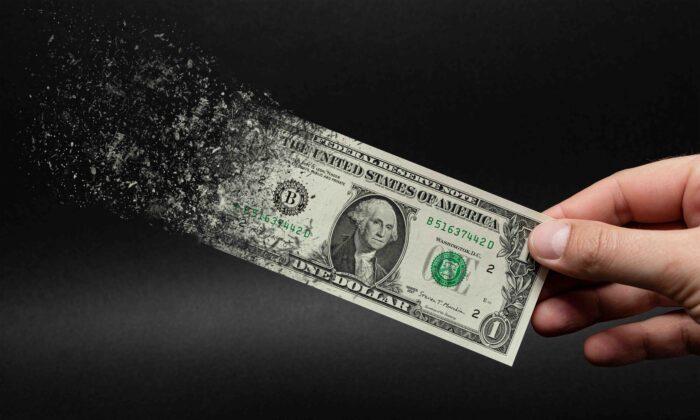“America at this moment stands at the summit of the world.” —Winston Churchill, 1950
At the end of World War II, the United States was far and away the world’s predominant economic and military power. America in 1950 was nothing less than an industrial colossus.
According to the International Organization of Motor Vehicle Manufacturers, the United States in 1950 produced 80 percent of the world’s automobiles, compared to about 6 percent today. The United States commanded a similarly outsized share in other spheres of economic production, with three-quarters or more of world output of machine tools, electronics, chemicals, airplanes, and computers.
The United States was self-sufficient in energy then. U.S. oilfields in 1950 accounted for over 50 percent of world oil production.
American industry produced more than twice the combined goods and services of all European industries. U.S. per capita production was 60 percent above Germany’s, 70 percent above France’s, and 80 percent above the UK’s.
U.S. GDP per capita was 4.52 times the average world GDP per capita in 1950. Total national output was more than three times that of the United States’ main rival—the late, not so great, Soviet Union. Such was the “Great Prosperity,” as F.A. Hayek dubbed the “unique 25-year period” of the postwar boom.
The United States had long surpassed Great Britain as the world’s largest economy. That happened in 1872. And the gap had continued to grow. (Although the total GDP of the British Empire substantially exceeded that of the United States in 1900).
The tragedy of World War I cost the United Kingdom dearly. The British were obliged to pay their own war costs and those of other combatants. The UK payments to Italy began with a grant of 50 million pounds to induce that country, previously an ally of Germany and Austro–Hungary, to enter World War I on the British/French side. By 1916, Britain was funding most of the Empire’s war expenditures, all of Italy’s, and two-thirds of the war costs of France and Russia.
Although the war finance plans were predicated on the false assumption that the war would soon be over, it dragged on for years at a ghastly expense. To meet the war’s high costs, the British national debt increased by a magnitude, from 650 million pounds in 1914 to 7.4 billion pounds in 1919.
As the war dragged on, its costs escalated to crippling levels. The cost of bullets and ammunition for a single day in September 1918 was 3.871 million pounds, equivalent to more than 191 million pounds ($249 million) in today’s money. More than a century later, 2 billion pounds worth of British debt from World War I still remains to be repaid.
World War I was the primary event that turned the United States from a net debtor to a net creditor. British investors were obliged to liquidate assets accumulated during the centuries of British hegemony, while the United States offered war loans to the UK.
By 1945, the United States was unquestionably a hegemonic power. “Hegemony” and “hegemonic” are out-of-town words describing one state’s political, economic, and military predominance over other states.
In ancient Greece, where the term originated, “hegemon” was an honorific title bestowed on the leaders of predominant states. For example, Alexander the Great was the hegemon of the Hellenic League. He led the Hellenic League to military victory over the Persian Empire.
Alexander’s claim to the title “hegemon” was based on his being the son and heir of King Philip, the previous hegemon of the Hellenic League.
An Economic Architecture Reflecting US Dominance
The emerging hegemonic power of the United States came into focus even before World War II came to an end. During a conference held at Bretton Woods, New Hampshire, from July 1–22, 1944, delegates from 44 nations met to discuss the postwar global order and establish a new international monetary system. This conference was held to avoid another global economic depression similar to the one that occurred in the wake of World War I. The theory that partnerships built on trade and economic ties would help discourage the outbreak of another world war led to constructing a new International Monetary Fund (IMF) and the World Bank.Both the IMF and the World Bank were established in Washington, D.C. These organizations aimed to monitor the movement and use of funds between nations, and provide loans to countries experiencing economic hardship.
At the Bretton Woods conference, exchange rates were linked to gold reserves. With the United States holding the bulk of the gold reserves in the world, the dollar emerged to replace the pound as the new reserve currency for international commerce and trade. While the IMF would oversee the maintenance of this new global economic system, the United States and the dollar emerged as the monetary standard-bearers for the postwar world.
Note that the emergence of the new dollar-centric reserve currency system led to a steady replacement of the British pound as the currency of record in commodity markets.
While the pound was the dominant currency of commodity markets during the heyday of the British Empire, there are now only a handful of raw materials whose trade is still denominated in sterling. The largest of these relic commodities is cocoa. A cocoa contract also trades in U.S. dollars in New York. But the sterling contract, started in 1928, continues to dominate trading in the physical cocoa market.
Until 30 years ago, other important commodities were denominated in pounds sterling. The London Metals Exchange copper contract was denominated in pounds sterling until 1993, and aluminum traded in sterling until 1987.
The remaining principal contracts in sterling were so-called “soft” commodities—tropical plantation commodities. Tea was traded in the UK currency until 1992, as was robust coffee, the lower quality bean used almost exclusively in instant coffee.
The Twilight of Hegemony
Undoubtedly, some of the hopes invested in the new institutions of American hegemony, like the IMF and the U.N., were exaggerated. Three-quarters of a century has passed. Still, the economic and military history of the post-war world was much superior to the record of the decades following World War I, which included the Great Depression and the Second World War.I am one of many who believe that the world economy performs more buoyantly and the prospects for peace are highest when economic, financial, and military power is concentrated in the hands of a single state. This view is borne out by the record.
Several Western countries served successively as the world’s hegemonic power in modern times. Wikipedia lists them as follows: Portugal (1494–1580), Holland (1580–1688), Britain (1688–1792 and 1815–1914). I would add the United States, from 1945.
While different experts list slightly different periods of hegemony for the different powers, several points shine through the record. No hegemonic power is listed from 1792 through 1815. This was a period of great upheaval, revolution, and world war. Napoleon came to power then and, as emperor of France, spread war across the European continent, among other things dissolving the Holy Roman Empire after the Battle of Austerlitz. Hegemony was eclipsed until Napoleon’s defeat at Waterloo, and the world suffered for it.
In the century of British hegemony that ended with World War I, there were few great wars, and the world economy thrived. As “Our World in Data” calculations compiled by the Martin School of the University of Oxford show, the English GDP (for which good data are available) had grown by 7.4 times at the eve of World War I since the final defeat of Napoleon in 1815.
World War II erupted not because Britain was unwilling to confront Hitler, although that played a role. Instead, the UK lacked the economic and military might to serve as an effective hegemon. On the other hand, the interwar period, when the world monetary system had been tossed into a cocked hat, was a period of economic distress and profound depression.
The days when “America stood at the summit of the world” are long past. We no longer produce most of the world’s automobiles, machine tools, and computers. As late as 1960, the U.S. economy was 40 percent of the world total (while China was at 4 percent).
In recent decades, the U.S. percentage of world output has remained relatively stable at just below 25 percent, while China’s share grew to 16.3 percent in 2019.
The U.S. dollar retained its status as the world’s reserve currency throughout this period, largely because oil sales were priced in dollars—and only in dollars.
“Saudi Arabia is in active talks with Beijing to price some of its oil sales to China in yuan,” the WSJ says, a move that could cripple not only the petrodollar’s dominance of the global petroleum market, but also a move aimed squarely at the heart of the U.S. financial system, which has taken advantage of the dollar’s reserve status by printing as many dollars as needed to fund government spending for the past decade.
According to the report, the talks with China over yuan-priced oil contracts have been off and on for six years. Still, talks have accelerated this year as the Saudis have grown increasingly unhappy with decades-old U.S. security commitments to defend the kingdom.
The Saudis are angry over the United States’ lack of support for their intervention in the Yemen civil war and the Biden administration’s attempt to strike a deal with Iran over its nuclear program. Saudi officials have said they were shocked by the abrupt U.S. withdrawal from Afghanistan last year.
The pricing of oil sales to China in yuan may hint that they plan to invade Taiwan, but I’m not convinced of that. It’s a threat of more inflation to come in the United States, as removing a big bid from the dollar would expose its pricing to the rigors of market fundamentals. Based on well-supported reporting, it’s clear that the embarrassing defeat in Afghanistan has devalued U.S. security guarantees in Saudi eyes.
For the time being, the greatest obstacle to the emergence of the Chinese yuan as a major transaction currency for the denomination of commodity trading is the reluctance of Beijing to liberalize its economy. Until the Chinese Communist Party is prepared to make the yuan fully convertible, its potential as a reserve currency will be limited.
Still, a shift to permit the Chinese to buy oil in yuan would hasten the demise of U.S. hegemony, and it would be particularly adverse to the preservation of the dollar’s role as the international reserve currency. The recent tendency of U.S. administrations to use sanctions as a blunderbuss to punish governments the United States finds to have misbehaved has heightened incentives to dethrone the dollar.
From the U.S. perspective, preserving the reserve currency status permits us to finance the yawning fiscal deficits in Washington by printing dollars at the expense of other countries. If the dollar is dethroned, the result to be expected would be a lower standard of living in the United States.
Another consequence would probably be a higher real burden of military spending. The United States might feel obliged to offset a decline in its “soft power” capabilities with greater “hard power.”





